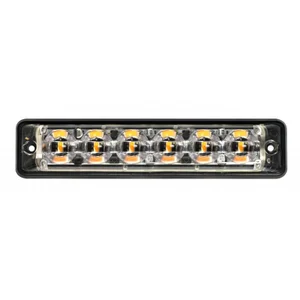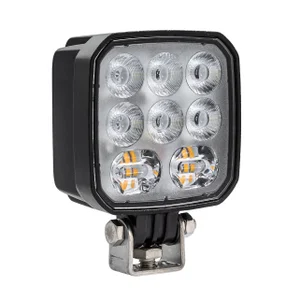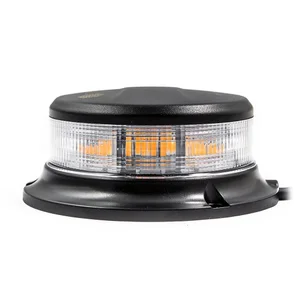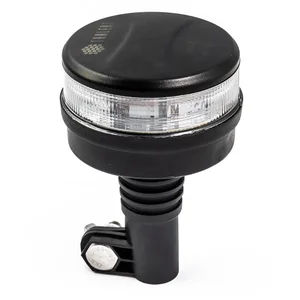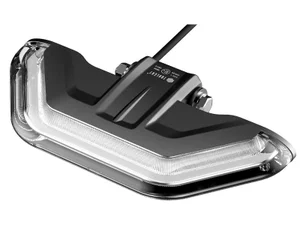In this blog you will learn:
- What rules apply to the use of optical safety signaling on vehicles, such as beacons, LED flashers, and work lights with flashing functions?
- You will learn about the European standardisation according to ECE R65, the difference between Class 1 and Class 2, and when dimmability is required or recommended.
- In addition, we provide practical examples per vehicle type and usage scenario, making it easy for you to determine which class best suits your application.
Does your signaling require ECE R65 Class 1 or Class 2 certification?
When choosing a beacon or flasher, it is important to first determine under which conditions it will be used. The ECE R65 standard distinguishes between two classes: Class 1 and Class 2. The main difference lies in the light intensity and visibility under different lighting conditions.
Light Intensity Class 1
Designed for use in dark conditions, such as at night or during poor visibility. Think of recovery vehicles operating at night, snowploughs working early in the morning, or vehicles operating in areas without street lighting. The lower intensity prevents unnecessary glare. More information about ECE R65 Class 1
Light Intensity Class 2
This is suitable for both day and night use. This type of lighting is more powerful and intended for vehicles operating in bright daylight or heavy traffic, such as gritting trucks, roadblock vehicles, or exceptional transport. Class 2 lighting includes an automatic or manual dimming function, ensuring compliance with lower intensity requirements at night. A flasher without a dimming function may meet the standard during the day but exceed the maximum values during night-time operation. To remain compliant with the regulation, dimmability is therefore necessary for night-time use of Class 2 flashers. More information about ECE R65 Class 2
Class 2 may be used during the day but is not required by law.
Maximum light values during day and night
The maximum permitted light intensity in the direct field of view (approximately within 10 degrees around the lamp) is 1,500 candela during the day, while at night it is limited to 600 candela. For oblique viewing angles (between 10 and 20 degrees), lower limits also apply: 1,000 candela during the day and only 300 candela at night.
Do you work exclusively in dark conditions? Then Class 1 is sufficient. Do you work both during the day and at night? Then choose a dimmable Class 2 lamp. This way, you stay flexible and within the permitted light intensity limits.
Which class suits which type of vehicle
| Vehicle Type | Usage Situation | Recommended Class |
|---|---|---|
| Agricultural vehicle | Work on field/country road, low speed | Class 1 |
| Mobile crane / construction machine (construction site) | Only within construction site | Class 1 |
| Industrial internal transport | Enclosed area, low speed, no external traffic | Class 1 |
| Tow truck / recovery vehicle | Public roads, highways, daytime use | Class 2 |
| Mobile crane / construction machine (public road) | Slow-moving vehicles on public roads | Class 2 |
| Escort vehicle / traffic guide | Escorting exceptional transport | Class 2 |
| Waste collection vehicle | Municipal routes, in residential areas | Class 2 |
| Gritting vehicle / snowplough | Poor weather conditions, often at night | Class 2 |
| Ambulance / fire brigade / police | Emergency response, day and night | Class 2 |
| Truck with wide load | Increased risk, mostly during the day | Class 2 |
| Runway vehicle (airport) | Movement on airports, visibility is crucial | Class 2 |
| ADR tanker (hazardous materials) | Public roads, continuous transport of hazardous goods | Class 2 |

To obtain an ECE R65 certificate, a light must be tested by an independent testing organization. The testing organization must demonstrate that the lighting meets the requirements of the directive. These requirements concern, among other things, the visibility, performance, and safety of the signal lighting.
An ECE R65 certificate is valid for a period of five years. After five years, the light must be retested to determine whether it still meets the directive's requirements.
Requirements applicable to ECE R65:
- Visibility: The signal lighting must be visible from all directions, including from a distance.
- Performance: The lighting must meet certain performance requirements, such as a minimum brightness and a minimum flash frequency.
- Safety: The lamp must not pose any danger to other road users.
When is signal lighting allowed to be used?
De Europese richtlijn schrijft het volgende voor:
''A rotating light/flash lamp may only be used on public roads if it complies with the ECE R65 directive.''
Uitvoering richtlijn ECE R65
The obligation to comply is laid down in national (Dutch) legislation and regulations. This falls under the 2009 Regulation on Optical and Acoustic Signals.
In the Netherlands, the RDW (National Road Traffic Service) is the authority responsible for the implementation of the ECE R65 directive. They thus determine whether a vehicle meets the conditions to be allowed on Dutch roads. Typically, this is at:
- Rescue, repair, recovery or towing of vehicles;
- Escorting transports for which an exemption has been granted;
- Escorting military columns;
- Agricultural, forestry, or off-road work vehicles that travel at a reduced speed, or trailers pulled by these vehicles that are wider than 2.60 m including the load;
- The transport of an indivisible load for which an exemption has been granted;
- Work around, on or on roads, including snow removal and gritting of slippery roads;
- Providing assistance on or near the road.
360-degree visibility
360-degree visibility with beacons means that the light is clearly visible from all angles to other road users, according to the Regulation on Optical and Sound Signals 2009. This enhances traffic safety by ensuring that the vehicle is well noticed in all situations.
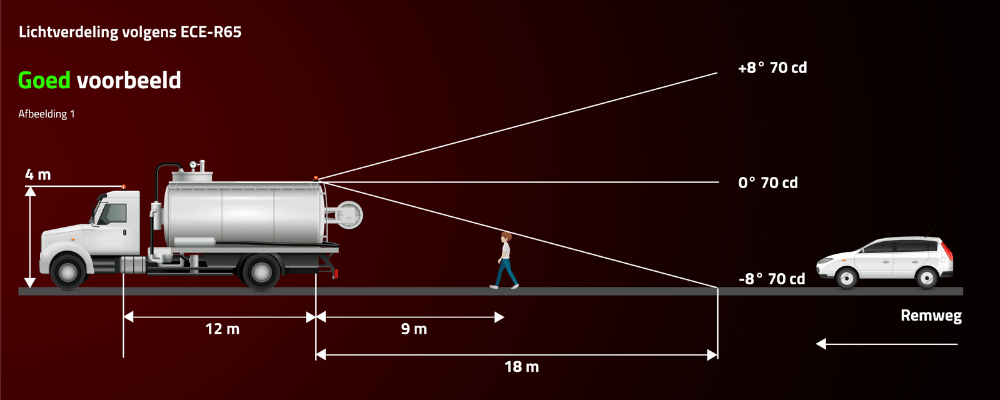
A rotating light/flashing light must be mounted on the vehicle in such a way that the warning signal is recognizable from every position at a distance of 25 meters. If this is not possible, additional warning systems (e.g., extra rotating lights/flashing lights) must be installed on the vehicle.
Good example: In the image above, it is shown that when a rotating light/flashing light is mounted 4 meters high on a vehicle, a person 1.80 meters tall can see the light beams from the lamp (at an angle of -8 degrees) from a distance of 15.7 meters from the vehicle.
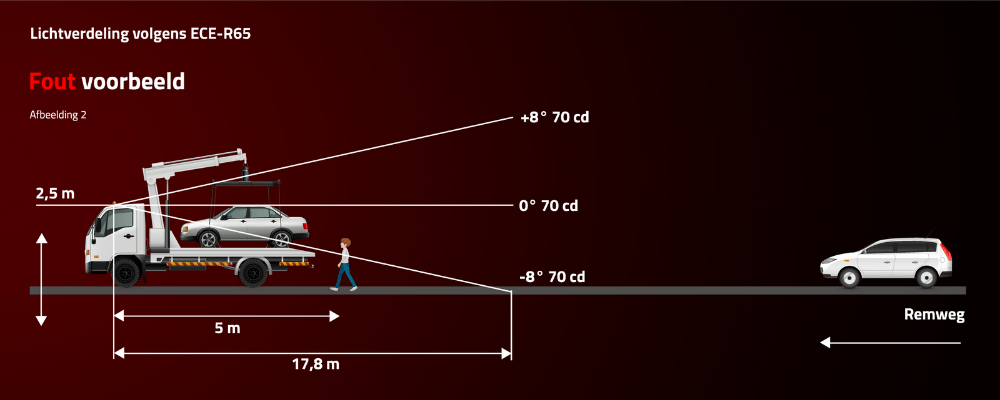
Incorrect example: In the image above, it is shown that the warning light is not recognizable from every direction. In the area of the crane, the warning effectiveness is interrupted. In this case, an additional warning light must be installed either at the rear of the vehicle or on the vehicle's cab.
According to the 'Regulation of Optical and Acoustic Signals 2009', '360-degree visibility' is required. This means that at least one of the signaling lights must be visible within a perimeter of 20 meters and from a viewing height of 1.5 meters.
If during operational activities parts of the vehicle such as cargo, loading cranes, wind deflectors, or the tailgate obstruct the view of the flash lamps, it is necessary to install additional flash lamps or supplementary flashers.
The installation of the lighting set must also be carried out in such a way that the light signal is observable from a perimeter of 20 meters around the entire vehicle, and from a height of 1.5 meters above the road surface.
What if you do not use ECE R65 signal lighting?
The use of non-certified signal lighting can entail various risks and dangers, both in terms of safety and legal liability. If an accident occurs, inspections may be carried out on this.
Using orange beacons on public roads
Are you planning to use an orange beacon on your vehicle? Then you have already learned that it must be equipped with ECE R65 if you want to use it on public roads.
You can use orange beacons in the following situations.
- In work involving the towing away of other vehicles.
- Accompanying transport for which exemption has been granted.
- For the guidance of military convoys
- When driving vehicles with limited speed, think of agricultural vehicles.
- Customs work.
In our blog, are you allowed to have orange flashing lights, you can read all the ins and outs.
Using blue beacons on public roads
This is only allowed in the Netherlands for:
- Road inspectors (from the Department of Public Works);
- Road inspectors (from the Department of Public Works);
- Organ transplantation transport;
- Explosive Ordnance Disposal Services;
- Fire brigade, both fire trucks and support vehicles;
- Undercover police cars;
- Police cars & riot vans;
- Enforcement;
In our blog, may you have blue beacons, you can read all the ins and outs.
Overview of all beacon colors;
Use blue beacon;
Police, ambulance, and fire brigade may only use blue beacons for urgent tasks.
Use green beacon;
Only the command vehicle belonging to the police, fire brigade, or ambulance may use green beacons.
Use yellow beacon;
Emergency services may only use yellow beacons to alert other road users to a special or dangerous situation. For example, when towing a broken-down vehicle. Emergency services using yellow beacons do not have special priority rights.
Read more about it on the page of the UK government
ECE R65 in de praktijk: er kunnen kleine verschillen op nationaal niveau zijn
Hoewel signaalverlichting met ECE R65-goedkeuring volledig voldoet aan de Italiaanse wetgeving, gelden in specifieke situaties aanvullende operationele voorschriften. Dit is met name het geval bij uitzonderlijk transport, technische begeleiding en civiele bescherming, waar eisen worden gesteld aan montagehoogte, zichtbaarheid en aanvullende signalisatie zoals reflecterende borden of vlaggen.
Deze voorschriften zijn vastgelegd in de Codice della Strada – Artikel 10 (Uitzonderlijk transport) en Artikel 153 (Verlichting en signalering), evenals in het Regolamento di Esecuzione – Artikel 38.
Germany
Hoewel signaalverlichting met ECE R65-goedkeuring voldoet aan de Duitse wetgeving, zoals vastgelegd in § 52 van de Straßenverkehrs-Zulassungs-Ordnung (StVZO), kunnen in de praktijk aanvullende richtlijnen gelden. Dit speelt vooral bij toepassingen zoals uitzonderlijk transport, wegbeheer of civiele bescherming. Denk aan extra eisen voor montagehoogte, zichtbaarheid of aanvullende signalering. Neem bij twijfel contact op met de lokale verkeersautoriteiten of een TÜV-instantie voor specifieke toepassingen.
UK
In het Verenigd Koninkrijk is signaalverlichting volgens ECE R65 geen wettelijke vereiste, maar wordt het sterk aanbevolen als best practice. Dit geldt met name voor voertuigen die betrokken zijn bij wegwerkzaamheden, uitzonderlijk transport of civiele bescherming. Aanvullende richtlijnen, zoals beschreven in het Traffic Signs Manual – Chapter 8, adviseren onder meer een minimale montagehoogte van 1,2 meter, 360° zichtbaarheid en extra reflecterende markeringen. Voor gedetailleerde eisen is het raadzaam om de richtlijnen van de Department for Transport of lokale autoriteiten te raadplegen.
Belgium
In Frankrijk is signaalverlichting volgens ECE R65 wettelijk verplicht voor voertuigen die betrokken zijn bij wegwerkzaamheden, uitzonderlijk transport of civiele bescherming. Deze verplichting is vastgelegd in de Franse verkeerswetgeving. Aanvullende richtlijnen kunnen specifieke eisen stellen aan montagehoogte, zichtbaarheid en extra reflecterende markeringen. Voor gedetailleerde eisen is het raadzaam om de richtlijnen van het Ministère de la Transition écologique et de la Cohésion des territoires of lokale autoriteiten te raadplegen.
France
In België is signaalverlichting volgens ECE R65 wettelijk verplicht voor voertuigen die betrokken zijn bij wegwerkzaamheden, uitzonderlijk transport of civiele bescherming. Deze verplichting is vastgelegd in de Belgische verkeerswetgeving. Aanvullende richtlijnen kunnen specifieke eisen stellen aan montagehoogte, zichtbaarheid en extra reflecterende markeringen. Voor gedetailleerde eisen is het raadzaam om de richtlijnen van de Federale Overheidsdienst Mobiliteit en Vervoer of lokale autoriteiten te raadplegen.
If you want customized advice from our specialists, feel free to contact us!
Heeft u vragen of advies nodig voor de bij specifieke vragen over de juiste zwaailampen of de montage daarvan.
Disclaimer: This information is general and informational; it is not intended as legal advice. TRALERT® is not liable and only provides specific advice regarding the ECE regulations.

